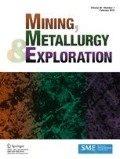Abstract
Separation of dolomite from phosphate is the most challenging problem in phosphate mineral processing. Over 50% of the future phosphate reserve in Florida contains too much dolomite to process using the current industry practice. The current phosphoric acid production practice requires less than 1% MgO in the phosphate concentrate as the feed material. The Florida Industrial and Phosphate (FIPR) Institute has collaborated with worldwide experts in the field to address this issue. As a result, the industry is now offered three feasible options. Option 1 offers three methods for reducing MgO content in the concentrate from the Crago process, including adding a dolomite depressant in the rougher flotation step, dolomite flotation of the cleaner concentrate, and scrubbing the cleaner concentrate in quartz sand. These methods could reduce MgO content in the final concentrate by 20–40%. Option 2 involves crushing and grinding of high-dolomite phosphate pebbles followed by dolomite flotation at slightly acidic pH using a new collector that does not require phosphoric acid as a phosphate depressant, achieving a final concentrate analyzing less than 0.9% MgO at about 87% P2O5 recovery. Option 3 is a gravity separation technique using an innovative separation jig, and its full potential remains to be demonstrated.






Similar content being viewed by others
References
El-Shall H, Bogan M (1994) Characterization of future Florida phosphate resources. FIPR Publication No. 02-082-105, Bartow, Florida, USA
El-Shall H, Bogan M (1994) Evaluation of dolomite separation techniques. FIPR Publication No. 02-094-108, Bartow, Florida, USA
Rule AR (1985) Beneficiation of complex phosphate ores containing carbonate and silica gangue. Proc XVth IMPC 3:380–389
Hsieh SS, Lehr JR (1985) Beneficiation of dolomitic Idaho phosphate rock by the TVA diphosphonic depressant process. Miner Metall Process 2:10–13
Snow RE (1982) Flotation of phosphate ores containing dolomite. U. S. Patent 4,364,824
Gruber GA et al. (2001) A pilot-scale demonstration of the IMC/CLDRI/FIPR flotation process for Florida high-MgO pebble. FIPR Publication #02-133-178, Bartow, Florida, USA
Smani S, Cases JM, Blazy P (1975) Beneficiation of sedimentary Moroccan phosphate ore, part 3. Selective flotation and recovery. Trans SME-AIME 258:176–180
Houot R (1982) Beneficiation of phosphatic ores through flotation: Review of industrial applications and potential developments. Int J Miner Process 9:353–384
Lehr JR, Hsieh SS (1981) Beneficiation of high carbonate phosphate ores. U S Patent 4,287,053
Lawendy TAB et al (1993) Flotation of dolomitic and calcareous phosphate ores. In: El-Shall H, Moudgil B, Wiegel R (eds) Beneficiation of phosphates: theory and practice. SME, Littleton, pp 231–243
Filho L et al (1993) The influence of corn starch on the separation of apatite from gangue minerals via froth flotation. In: El-Shall H, Moudgil B, Wiegel R (eds) Beneficiation of phosphates: theory and practice. SME, Littleton, pp 147–155
Wiegel R (1999) Phosphate rock beneficiation practice in Florida. In: Zhang P, El-Shall H, Wiegel (eds) Beneficiation of phosphates: advances in research and practice. SME, Littleton, pp 271–275
Zhang P, Snow RE, Bogan M (2002) A screening study on phosphate depressants for beneficiating Florida phosphate minerals. FIPR Publication 02-101-183, Bartow, Florida, USA
Zhang P, Zheng SB, Sun WY, Ma XQ, Miller JD (2012) Development of reagent schemes for reducing MgO content in the flotation concentrate for processing Florida’s high-dolomite phosphate deposits. FIPR Publication # 02-179-246, Bartow, Florida, USA
Gu ZX, Gao ZZ, Hwang C (1999) Development of new technology for beneficiation of Florida dolomitic phosphate resources, FIPR Publication No. 02-129-167, Bartow, Florida USA
Gruber G, Zheng SB, Hwang C (2001) A pilot scale demonstration of the IMC/CLDRI/FIPR flotation process for Florida high-MgO Pebble. FIPR Publication No. 02-133-178, Bartow, Florida, USA
Gao ZZ, Zheng SB, Guan C, Hwang C (2003) Optimizing the formulation for dolomite collector PA-31 using raw materials from the United States. FIPR Publication No. 02-150-197, Bartow, Florida, USA
Miller J, Lin CL, Ahmed I, Wang X, Zhang P (2012) Advanced instrumentation for mineral liberation analysis and use in phosphate industry. In: Zhang P, Miller J, El-Shall H (eds) Beneficiation of phosphates: new thought, new technology, new development. SME, Englewood, pp 167–176
Yang DC (1996) Device and process for gravitational separation of solid particles. US Patent No. 5,507,393
Drummond R, Nicol S, Swanson A (2002) Teetered bed separators -the Australian experience. J South Afr Inst Min Metall 10:385–392
Dai Q (1999) Simulation of packed column jigging. Master’s Thesis, West Virginia University, Morgantown, West Virginia
Yang DC, Meloy TP (1997) Gravity separation of minus 500 mesh particles. Presented at SME Annual Meeting. Denver, Colorado
Yang DC, Bozzato P, Ferrara G (2003) Iron ore beneficiation with packed column jig. J Miner Mater Charact Eng 2(1):43–51
Funding
All the research projects presented in this paper were funded by the Florida Industrial and Phosphate Research Institute, Florida Polytechnic University. All Florida phosphate companies participated in the research projects and provided technical input and in-kind supports.
Author information
Authors and Affiliations
Corresponding author
Ethics declarations
Conflict of Interest
The authors declare that they have no conflict of interest.
Glossary
- PA-31
-
The earliest version of a dolomite collector developed for processing Florida high-dolomite phosphate pebbles and manufactured in China. It is a fatty acid soap with a surfactant.
- PA-46
-
The second generation of PA-31, a fatty acid soap with a different source of fatty acid.
- PA-66
-
The third generation of PA-31, a fatty acid soap formulated for dolomite flotation without adding phosphoric acid.
- PA-67
-
An improved version of PA-66, a fatty acid soap formulated for improved selectivity by using higher quality fatty acid and a new surfactant.
- USPA-31
-
A dolomite collector produced using raw materials from the USA based on the formulation of PA-31.
Rights and permissions
About this article
Cite this article
Zhang, P., Zheng, S., Song, W. et al. Promising Options for Solving the Dolomite Problem of the Florida Phosphate Resources—a Brief Review. Mining, Metallurgy & Exploration 36, 117–129 (2019). https://doi.org/10.1007/s42461-018-0038-2
Received:
Accepted:
Published:
Issue Date:
DOI: https://doi.org/10.1007/s42461-018-0038-2




